Spatiotemporal Evolution of Urban Shrinkage and Its Impact on Urban Resilience in Three Provinces of Northeast China
Abstract
1. Introduction
2. Materials and Methods
2.1. Study Area
2.2. The Comprehensive Evaluation System for Urban Shrinkage and Urban Resilience
2.2.1. Urban Shrinkage
2.2.2. Urban Resilience
2.3. Theoretical Mechanisms of Urban Shrinkage’s Impact on Urban Resilience
2.4. Methods
2.4.1. Analytic Hierarchy Process
2.4.2. Shrinkage Model
2.4.3. Mediation Model
2.5. Data Sources
3. Spatiotemporal Evolution of Urban Shrinkage and Urban Resilience
3.1. Spatiotemporal Evolution of Urban Shrinkage
3.1.1. Spatiotemporal Evolution Features
3.1.2. Spatial Differences in Urban Shrinkage
3.2. Spatiotemporal Evolution of Urban Resilience
3.2.1. Urban Resilience Tended to Be Balanced, with Economic Resilience Dominating
3.2.2. Spatial Differences in Urban Resilience Were Evident, and the Spatial Correlation Tended to Increase over Time
3.2.3. There Were Differences in the Resilience of Shrinking Cities of Different Types, and Their Resilience Was Lower Than the Average Level
4. The Impact of Urban Shrinkage on Urban Resilience
4.1. Correlation between Urban Shrinkage and Urban Resilience
4.2. The Impact Path of Urban Shrinkage on Urban Resilience
5. Discussion
5.1. Different Impacts of Various Dimensions of Urban Shrinkage on Urban Resilience
5.2. The Path to Improve Resilience in Shrinking Cities
5.3. Limitations and Prospects
6. Conclusions
- (1)
- Urban shrinkage was a prominent phenomenon in the three provinces of Northeast China, exhibiting significant spatiotemporal variations across different dimensions of shrinkage. More than half of the cities in these provinces were experiencing shrinkage, although the implementation of the Northeast revitalization strategy led to a narrowing of the shrinkage scope. Among the various dimensions, population-related shrinkage was the most widespread, with the number of shrinking cities continuing to increase. These shrinking cities were concentrated in both the northern and southern regions. Economy-related shrinkage was particularly severe, especially in Liaoning Province, although there were some indications of relief in the shrinkage trend. Space-related shrinkage showed a relatively moderate pattern, with shrinking cities dispersed throughout the region.
- (2)
- There was notable spatiotemporal variation in urban resilience across the three provinces of Northeast China, particularly in shrinking cities where resilience was comparatively lower. The coefficient of variation indicates a decreasing trend, suggesting a more balanced development of urban resilience, with economic resilience consistently ranking first. In spatial terms, there was a significant positive correlation that tended to strengthen over time. The resilience of shrinking cities fell below the average level, with cities facing population-related and economy-related shrinkage showing the lowest levels of economic resilience, and this trend was declining. Among these, space-shrinking cities exhibited the weakest infrastructure resilience.
- (3)
- The urban shrinkage index showed a significant positive correlation with the urban resilience index, indicating that different dimensions of urban shrinkage have varying impacts on urban resilience. Firstly, the Spearman’s correlation coefficient between the urban shrinkage index and the urban resilience index was positive. Secondly, urban shrinkage could directly or indirectly influence urban resilience. It could directly decrease urban resilience and could also exert an impact through intermediate factors such as innovation capacity and cultural development, further hindering urban resilience. Lastly, among the different dimensions of urban shrinkage, population-related shrinkage had the most pronounced impact on urban resilience. All three dimensions could directly impair urban resilience, but the influence on urban resilience through intermediate variables differed.
Author Contributions
Funding
Data Availability Statement
Conflicts of Interest
References
- Wiechmann, T.; Pallagst, K.M. Urban Shrinkage in Germany and the USA: A Comparison of Transformation Patterns and Local Strategies. Int. J. Urban Reg. Res. 2012, 36, 261–280. [Google Scholar] [CrossRef] [PubMed]
- Guo, Y.Y.; Li, L. Change in the Negative Externality of the Shrinking Cities in China. Sci. Geogr. Sin. 2019, 39, 52–60. [Google Scholar] [CrossRef]
- Hu, Y.C.; Liu, Y.J.; Sun, H.R. Process and Factors of Urban Growth and Shrinkage: A Case Study of Mining Cities in Heilongjiang Province. Sci. Geogr. Sin. 2020, 40, 1450–1459. [Google Scholar] [CrossRef]
- Wu, K.; Long, Y.; Yang, Y. Urban Shrinkage in the Beijing-Tianjin-Hebei Region and Yangtze River Delta: Pattern, Trajectory, and Factors. Mod. Urban Res. 2015, 26–35. [Google Scholar] [CrossRef]
- Sun, P.J.; Wang, K.W. Identification and Stage Division of Urban Shrinkage in the Three Provinces of Northeast China. Acta Geogr. Sin. 2021, 76, 1366–1379. [Google Scholar] [CrossRef]
- Zhang, W.; Shan, F.F.; Zheng, C.G.; Hu, R. Multi-Dimensional Identification and Driving Mechanism Analysis of Shrinking City in China. Urban Dev. Stud. 2019, 26, 32–40. [Google Scholar] [CrossRef]
- Wu, K.; Sun, D.Q. Progress in Urban Shrinkage Research. Econ. Geogr. 2017, 37, 59–67. [Google Scholar] [CrossRef]
- Howe, S.R.; Bier, T.; Allor, D.; Finnerty, T.; Green, P. The Shrinking Central City Amidst Growing Suburbs: Case Studies of Ohio’s Inelastic Cities. Urban Geogr. 1998, 19, 714–734. [Google Scholar] [CrossRef]
- Oswalt, P.; Rieniets, T. Atlas of Shrinking Cities; Hatje Cantz Publishers: Ostfildern, Germany, 2006; pp. 14–15. Available online: https://www.research-collection.ethz.ch/handle/20.500.11850/25547 (accessed on 8 May 2023).
- Jaroszewska, E.; Stryjakiewicz, T. Drivers, Scale, and Geography of Urban Shrinkage in Poland and Policy Responses. J. Urban Plan. Dev. 2020, 146, 05020021. [Google Scholar] [CrossRef]
- Du, Z.W.; Li, X. Growth or Shrinkage: New Phenomena of Regional Development in the Rapidly-Urbanising Pearl River Delta. Acta Geogr. Sin. 2017, 72, 1800–1811. [Google Scholar] [CrossRef]
- Deng, C.X.; Liang, P.; Liu, C.C. Analysis of the Changing Characteristics and Influencing Factors of the Shrinking City Space-Time in the Middle-Stream City Group of the Yangtze River. J. Urban Stud. 2020, 41, 80–88. [Google Scholar] [CrossRef]
- Zhou, K.; Tu, H.; Dai, Y.G. Spatial Adjustment of Shrinking Cities in the Territorial Spatial Planning. Econ. Geogr. 2021, 41, 212–220. [Google Scholar] [CrossRef]
- Liu, G.W.; Xie, F.Y.; Hong, J.K.; Chen, C.J. Urban Shrinkage in China Based on the Data of Population and Economy. Econ. Geogr. 2019, 39, 50–57. [Google Scholar] [CrossRef]
- Robert, A.B. Aberrant Cities: Urban Population Loss in the United States, 1820–1930. Urban Geogr. 2003, 24, 672–690. [Google Scholar] [CrossRef]
- Hollander, J.B.; Németh, J. The Bounds of Smart Decline: A Foundational Theory for Planning Shrinking Cities. Hous. Policy Debate 2011, 21, 349–367. [Google Scholar] [CrossRef]
- Chen, W.K.; Yan, C.H.; Li, W.; Yang, Y.Y. Coupling System-Based Spatiotemporal Variation and Influence Factors Analysis of City Shrinkage in Henan. Pol. J. Environ. Stud. 2021, 30, 3497–3510. [Google Scholar] [CrossRef]
- Schetke, S.; Haase, D. Multi-Criteria Assessment of Socio-Environmental Aspects in Shrinking Cities: Experiences from Eastern Germany. Environ. Impact Assess. Rev. 2008, 28, 483–503. [Google Scholar] [CrossRef]
- Blanco, H.; Alberti, M.; Forsyth, A.; Krizek, K.J.; Rodríguez, D.A.; Talen, E.; Ellis, C. Hot, Congested, Crowded and Diverse: Emerging Research Agendas in Planning. Prog. Plan. 2009, 71, 153–205. [Google Scholar] [CrossRef]
- Dubeaux, S.; Sabot, E.C. Maximizing the Potential of Vacant Spaces Within Shrinking Cities, a German Approach. Cities 2018, 75, 6–11. [Google Scholar] [CrossRef]
- Du, Z.W.; Zhang, H.O.; Ye, Y.Y.; Jin, L.X.; Xu, Q. Urban Shrinkage and Growth: Measurement and Determinants of Economic Resilience in the Pearl River Delta. J. Geogr. Sci. 2019, 29, 1331–1345. [Google Scholar] [CrossRef]
- Xie, M.K.; Feng, Z.X.; Li, C.G. How Does Population Shrinkage Affect Economic Resilience? A Case Study of Resource-Based Cities in Northeast China. Sustainability 2022, 14, 3650. [Google Scholar] [CrossRef]
- Sun, J.W.; Sun, X.Y. Research Progress of Regional Economic Resilience and Exploration of Its Application in China. Econ. Geogr. 2017, 37, 1–9. [Google Scholar] [CrossRef]
- Holling, C.S. Resilience and Stability of Ecological Systems. Annu. Rev. Ecol. Syst. 1973, 4, 1–23. [Google Scholar] [CrossRef]
- Balland, P.A.; Rigby, D. The Geography of Complex Knowledge. Econ. Geogr. 2017, 93, 1–23. [Google Scholar] [CrossRef]
- Tan, J.T.; Zhao, H.B.; Liu, W.X.; Zhang, P.Y.; Qiu, F.D. Regional Economic Resilience and Influential Mechanism During Economic Crises in China. Sci. Geogr. Sin. 2020, 40, 173–181. [Google Scholar] [CrossRef]
- Pickett, S.T.A.; Cadenasso, M.L.; Grove, J.M. Resilient Cities: Meaning, Models, and Metaphor for Integrating the Ecological, Socio-Economic, and Planning Realms. Landsc. Urban Plan. 2004, 69, 369–384. [Google Scholar] [CrossRef]
- Zhao, R.D.; Fang, C.L.; Liu, H.M. Progress and Prospect of Urban Resilience Research. Prog. Geogr. 2020, 39, 1717–1731. [Google Scholar] [CrossRef]
- Ning, J.; Zhu, R.; Zhang, X.Y.; Chen, K. Evaluation and Analysis of Urban Resilience in Inner Mongolia. Arid Land Geogr. 2022. [Google Scholar] [CrossRef]
- Hudec, O.; Reggiani, A.; Šiserová, M. Resilience Capacity and Vulnerability: A Joint Analysis with Reference to Slovak Urban Districts. Cities 2018, 73, 24–35. [Google Scholar] [CrossRef]
- Bai, L.M.; Xiu, C.L.; Feng, X.H.; Mei, D.W.; Wei, Y. A Comprehensive Assessment of Urban Resilience and Its Spatial Differentiation in China. World Reg. Stud. 2019, 28, 77–87. [Google Scholar] [CrossRef]
- Folke, C. Resilience: The Emergence of a Perspective for Social-Ecological Systems analyses. Glob. Environ. Chang. 2006, 16, 253–267. [Google Scholar] [CrossRef]
- Suzanne, V.; Sally, C. First to Respond, Last to Leave: Communities’ Roles and Resilience Across the ‘4Rs’. Int. J. Disaster Risk Reduct. 2015, 14, 27–36. [Google Scholar] [CrossRef]
- Paul, J.M.; Charles, P. Factors in the Resilience of Electrical Power Distribution Infrastructures. Appl. Geogr. 2012, 32, 668–679. [Google Scholar] [CrossRef]
- Luo, Z.Y.; Zeng, J. Research Evolution and Prospect of Resilience Urban Planning and Design. Mod. Urban Res. 2022, 37, 51–59. [Google Scholar] [CrossRef]
- Sun, P.J.; Zhang, K.Q.; He, T. Shrinkage Effect of Urban-Rural Integration on Shrinking Cities in the Three Provinces of Northeast China and Mechanism. Prog. Geogr. 2022, 41, 1213–1225. [Google Scholar] [CrossRef]
- Chen, X.H.; Lou, J.N.; Wang, Y. Evolution and Dynamic Simulation of the Temporal-Spatial Pattern of Urban Resilience in Harbin-Changchun Urban Group. Sci. Geogr. Sin. 2020, 40, 2000–2009. [Google Scholar] [CrossRef]
- Zhang, S.; Wang, C.X.; Li, B. Spatial Differentiation of Urban Economic Elasticity and Its Influencing Factors in Northeast China. Hum. Geogr. 2019, 34, 73–80. [Google Scholar] [CrossRef]
- Wang, S.M.; Niu, J.L. Dynamic Evolution and Obstacle Factors of Urban Ecological Resilience in Shandong Peninsula Urban Agglomeration. Econ. Geogr. 2022, 42, 51–61. [Google Scholar] [CrossRef]
- Chen, S.Q.; Xia, A.T. Spatio-Temporal Evolution of Urban Resilience and Diagnosis of Obstacle Factors in Rapid Urbanization Regions: A Case Study of the Urban Agglomerations in the Middle Reaches of the Yangtze River. Mod. Urban Res. 2020, 35, 37–44, 103. [Google Scholar] [CrossRef]
- Bristow, G.; Healy, A. Innovation and Regional Economic Resilience: An Exploratory Analysis. Ann. Reg. Sci. 2017, 60, 265–284. [Google Scholar] [CrossRef]
- Sun, P.J.; Wang, K.W. Urban Shrinkage: Connotation-Sinicization-Framework of Analysis. Prog. Geogr. 2022, 41, 1478–1491. [Google Scholar] [CrossRef]
- Chen, D.; Fang, C.L.; Liu, Z.T. Progress and Major Themes of Research on Urban Shrinkage and Its Eco-Environmental Impacts. J. Geogr. Sci. 2023, 33, 1113–1138. [Google Scholar] [CrossRef]
- Zhang, S.; Wang, C.X.; Wang, J.; Yao, S.M.; Zhang, F.; Yin, G.W.; Xu, X.Y. On the Comprehensive Measurement of Urban Shrink in China and Its Spatio-Temporal Differentiation. China Popul. Resour. Environ. 2020, 30, 72–82. [Google Scholar] [CrossRef]
- Yu, S.K.; Wang, C.X.; Jin, Z.X.; Zhang, S.; Miao, Y. Spatiotemporal Evolution and Driving Mechanism of Regional Shrinkage at the County Scale: The Three Provinces in Northeastern China. PLoS ONE 2022, 17, e0271909. [Google Scholar] [CrossRef]
- Chen, Y.M.; Li, L.X.; Fu, T.L. Spatial Heterogeneity in Chinese Urban Innovation Capabilities and Its Determinants: Approach Based on the Geographically Weighted Regression Model. Trop. Geogr. 2020, 40, 323–334. [Google Scholar] [CrossRef]
- Zhang, M.D.; Xiao, H. Spatial Pattern Characteristics and Mechanism of Urban Shrinkage in Northeast China. Urban Probl. 2020, 294, 33–42. [Google Scholar] [CrossRef]
- Zhang, S.S.; Ma, X.Y.; Xiong, J.L.; Cui, Q. The Impact of Population Agglomeration on Urban Resilience. Northwest Popul. J. 2023, 44, 76–90. [Google Scholar] [CrossRef]
- Zhang, M.D.; Feng, X.Q. Comprehensive Evaluation of Urban Resilience in China. Urban Probl. 2018, 279, 27–36. [Google Scholar] [CrossRef]
- Zhao, J.H.; Li, C.G.; Ma, Z.P.; Hu, S.J. Urban Shrinking Smart and Transformation of China’s Old Industrial Bases. Urban Dev. Stud. 2017, 24, 135–138, 152. [Google Scholar] [CrossRef]
- Huang, M.H.; Zhang, W.G. Comparison of Resilience Levels and Development Strategies of Four Types of Resource-Based Cities in China. Econ. Geogr. 2023, 43, 34–43. [Google Scholar] [CrossRef]
- Zhang, M.D.; Qu, J.X. Spatial Patterns, Analytical Frameworks, and Implementation Paths of Urban Smart Shrinkage. Study Pract. 2018, 418, 16–25. [Google Scholar] [CrossRef]
- Wolff, M.; Mykhnenko, V. COVID-19 as a Game-Changer? The Impact of the Pandemic on Urban Trajectories. Cities 2023, 134, 104162. [Google Scholar] [CrossRef]
- Tian, C.H.; Peng, X.T.; Zhang, X. COVID-19 Pandemic, Urban Resilience and Real Estate Prices: The Experience of Cities in the Yangtze River Delta in China. Land 2021, 10, 960. [Google Scholar] [CrossRef]
- Yuan, Z.H.; Hu, W.Y. Urban Resilience to Socioeconomic Disruptions During the COVID-19 Pandemic: Evidence from China. Int. J. Disaster Risk Reduct. 2023, 91, 103670. [Google Scholar] [CrossRef]
- Wei, F.; Yin, W.X.; Hu, B.T. Economic Resilience and Influencing Factors of Yangtze River Delta Under the Impact of the COVID-19. J. Ind. Technol. Econ. 2023, 42, 119–128. [Google Scholar] [CrossRef]
- Cui, P.; Dong, Z.Y.; Yao, X.; Cao, Y.F.; Sun, Y.F.; Feng, L. What Makes Urban Communities More Resilient to COVID-19? A Systematic Review of Current Evidence. Int. J. Environ. Res. Public Health 2022, 19, 10532. [Google Scholar] [CrossRef]
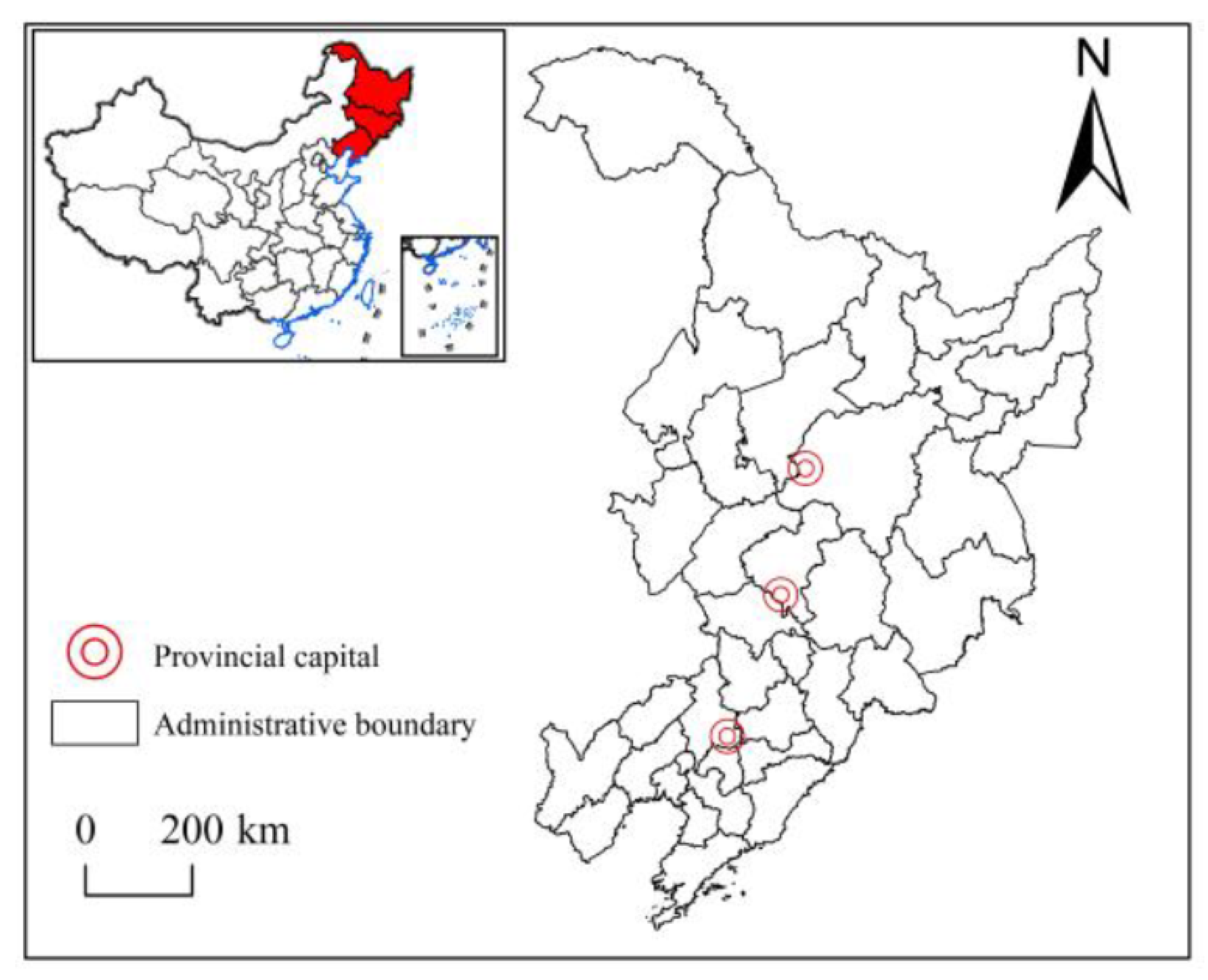
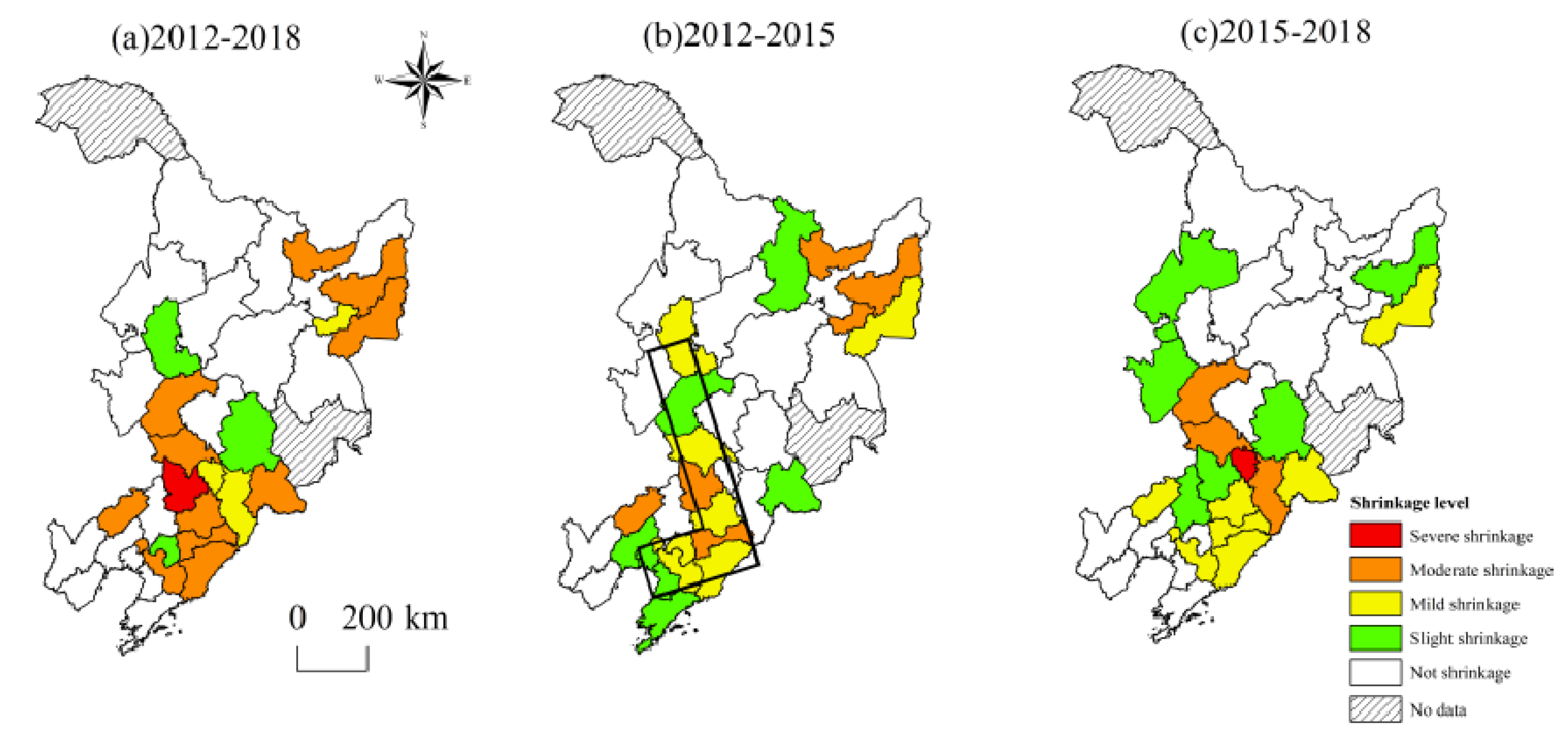
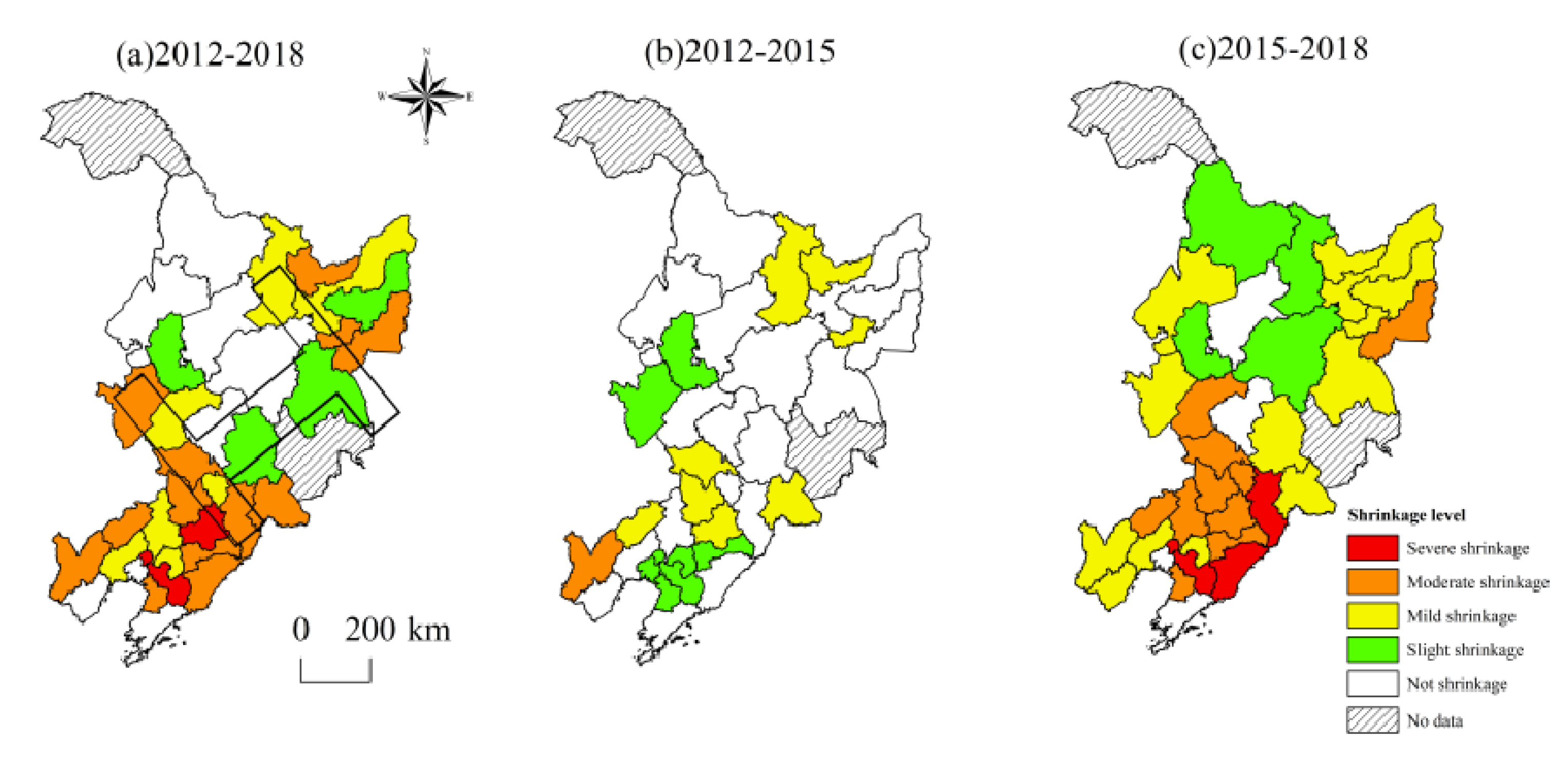
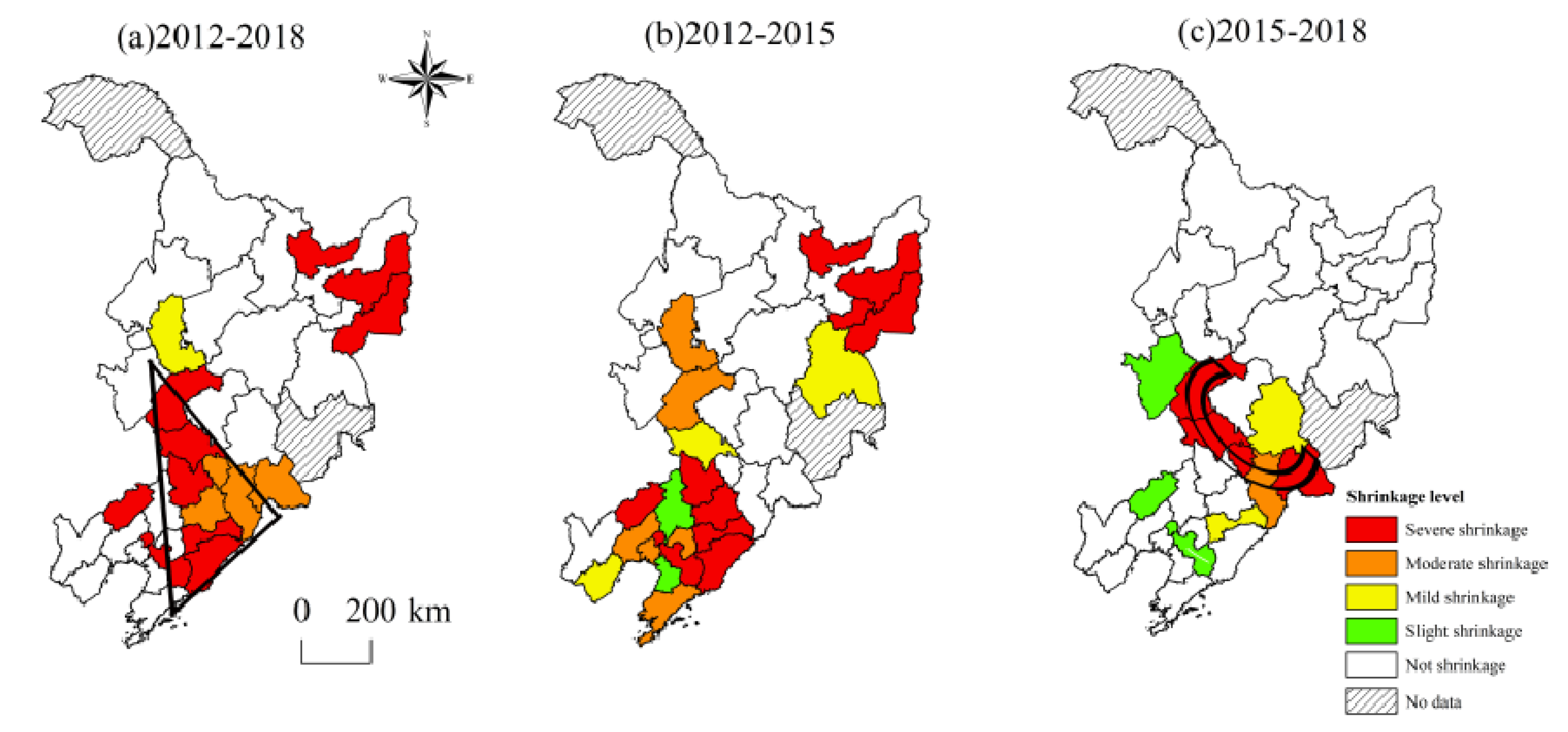

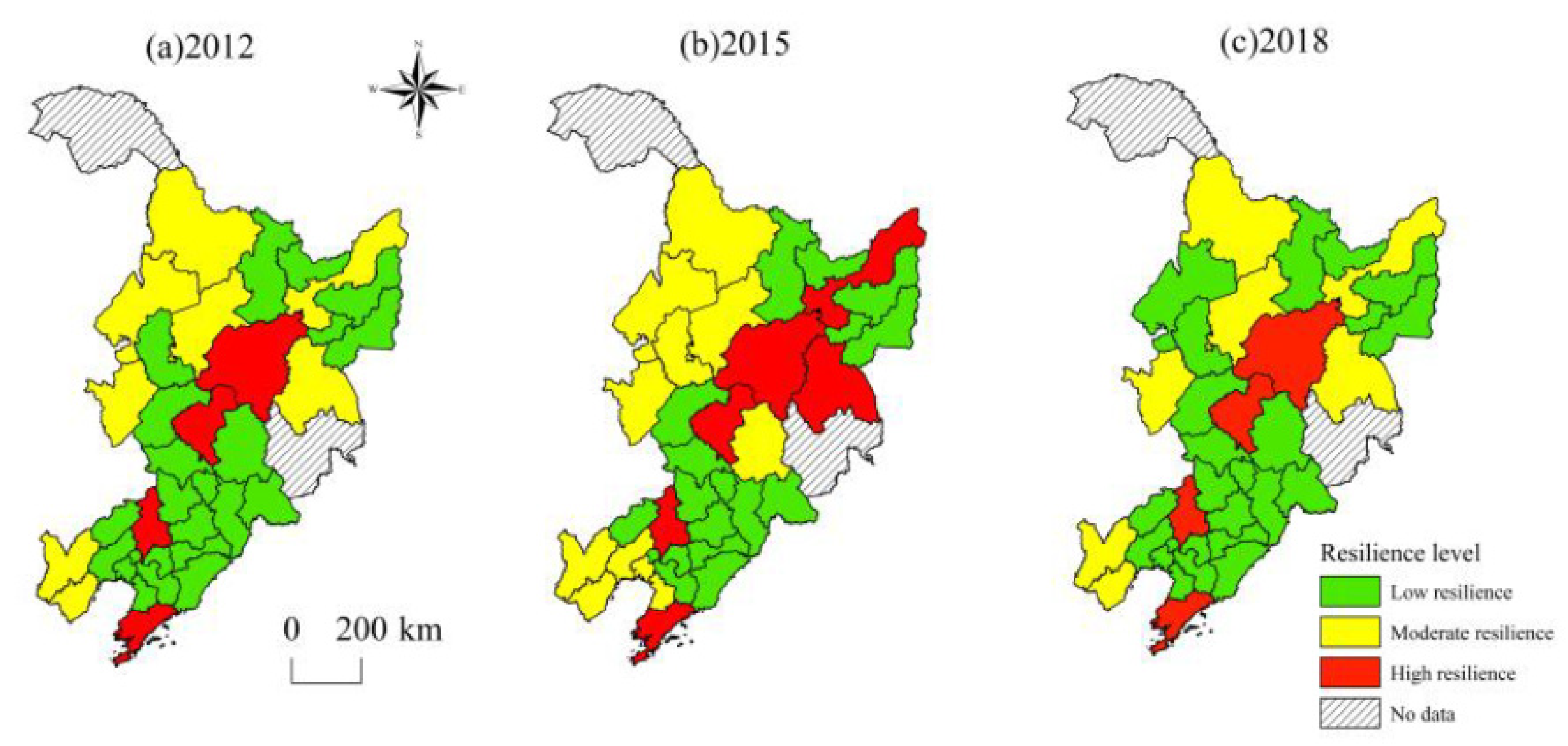
| Target Layer | Criterion Layer | Weight | Indicator Layer | Weight |
|---|---|---|---|---|
| Urban shrinkage | Population | 0.5 | Permanent population | 0.572 |
| Number of employees | 0.428 | |||
| Economy | 0.3 | GDP | 0.525 | |
| Fiscal revenue | 0.475 | |||
| Space | 0.2 | Built-up area | 0.462 | |
| Night-time light index | 0.538 |
| Target Layer | Criterion Layer | Indicator Layer | Weight |
|---|---|---|---|
| Urban resilience | Economic resilience | Percentage of secondary and tertiary industries (%) | 0.0513 |
| Number of enterprises above designated size | 0.0363 | ||
| Balance of residents’ savings (RMB 10,000 yuan) | 0.0467 | ||
| Actual utilization of foreign capital (10,000 USD) | 0.0339 | ||
| Percentage of science and technology expenditure in GDP (%) | 0.0545 | ||
| Total retail sales of social consumer goods per capita | 0.0377 | ||
| Social resilience | Natural population growth rate (%) | 0.0423 | |
| Number of college students per 10,000 people | 0.0366 | ||
| Coverage of medical insurance (%) | 0.0271 | ||
| Average wage of employees (RMB yuan) | 0.0399 | ||
| Registered unemployed population in urban areas | 0.0462 | ||
| Social dependency ratio (%) | 0.0408 | ||
| Ecological resilience | Rate of green coverage (%) | 0.0548 | |
| Area of gardens and green spaces (km2) | 0.0378 | ||
| Comprehensive utilization of industrial solid wastes (%) | 0.043 | ||
| Centralized treatment of urban domestic sewage (%) | 0.0437 | ||
| Harmless disposal of domestic wastes (%) | 0.0395 | ||
| Discharge of industrial wastewater per RMB 10,000 yuan of GDP (ton) | 0.0559 | ||
| Infrastructure resilience | Per capita road area (m2 per capita) | 0.0473 | |
| Drainage pipeline density (km/km2) | 0.0568 | ||
| Number of buses (electric vehicles) per 10,000 people | 0.0372 | ||
| Number of hospital beds per 10,000 people | 0.0367 | ||
| Number of mobile phone owners | 0.0272 | ||
| Number of Internet users | 0.0268 |
| Severe Shrinkage | Moderate Shrinkage | Mild Shrinkage | Slight Shrinkage | Total | ||||||
|---|---|---|---|---|---|---|---|---|---|---|
| Quantity | Percentage (%) | Quantity | Percentage (%) | Quantity | Percentage (%) | Quantity | Percentage (%) | Quantity | Percentage (%) | |
| Comprehensively shrinking city | 1 | 2.94 | 11 | 32.35 | 3 | 8.82 | 3 | 8.82 | 18 | 52.94 |
| Population-related shrinking city | 2 | 5.88 | 13 | 38.24 | 7 | 20.59 | 4 | 11.76 | 26 | 76.47 |
| Economy-related shrinking city | 10 | 29.41 | 4 | 11.76 | 1 | 2.94 | 0 | 0 | 15 | 44.12 |
| Space-related shrinking city | 0 | 0 | 1 | 2.94 | 3 | 8.82 | 4 | 11.76 | 8 | 23.53 |
| Severe Shrinkage | Moderate Shrinkage | Mild Shrinkage | Slight Shrinkage | Total | ||||||
|---|---|---|---|---|---|---|---|---|---|---|
| Quantity | Percentage (%) | Quantity | Percentage (%) | Quantity | Percentage (%) | Quantity | Percentage (%) | Quantity | Percentage (%) | |
| Comprehensively shrinking city | 0 | 0 | 6 | 17.65 | 7 | 20.59 | 7 | 20.59 | 20 | 58.82 |
| Population-related shrinking city | 0 | 0 | 1 | 2.94 | 8 | 23.53 | 7 | 20.59 | 16 | 47.06 |
| Economy-related shrinking city | 10 | 29.41 | 6 | 17.65 | 3 | 8.82 | 2 | 5.88 | 21 | 61.76 |
| Space-related shrinking city | 1 | 2.94 | 0 | 0 | 4 | 11.76 | 8 | 23.53 | 13 | 38.24 |
| Severe Shrinkage | Moderate Shrinkage | Mild Shrinkage | Slight Shrinkage | Total | ||||||
|---|---|---|---|---|---|---|---|---|---|---|
| Quantity | Percentage (%) | Quantity | Percentage (%) | Quantity | Percentage (%) | Quantity | Percentage (%) | Quantity | Percentage (%) | |
| Comprehensively shrinking city | 1 | 0 | 3 | 8.82 | 7 | 20.59 | 6 | 17.65 | 17 | 50.00 |
| Population-related shrinking city | 3 | 0 | 10 | 29.41 | 13 | 38.24 | 4 | 11.76 | 30 | 88.24 |
| Economy-related shrinking city | 4 | 11.76 | 1 | 2.94 | 2 | 5.88 | 3 | 8.82 | 10 | 29.41 |
| Space-related shrinking city | 0 | 0 | 1 | 2.94 | 1 | 2.94 | 5 | 14.71 | 7 | 20.59 |
| Urban Resilience | Economic Resilience | Social Resilience | Ecological Resilience | Infrastructure Resilience | |
|---|---|---|---|---|---|
| 2012 | 0.7007 | 0.7057 | 0.9662 | 0.6467 | 0.1214 |
| 2015 | 0.6990 | 0.6452 | 0.9403 | 0.6403 | 0.1344 |
| 2018 | 0.6967 | 0.5064 | 0.9130 | 0.5674 | 0.1489 |
| Period | Comprehensively Shrinking City | Population-Related Shrinking City | Economy-Related Shrinking City | Space-Related Shrinking City | ||||
|---|---|---|---|---|---|---|---|---|
| Spearman’s Coefficient | Sig. | Spearman’s Coefficient | Sig. | Spearman’s Coefficient | Sig. | Spearman’s Coefficient | Sig. | |
| 2012–2015 | 0.364 ** | 0.034 | 0.920 *** | 0.000 | 0.304 * | 0.080 | 0.336 * | 0.052 |
| 2015–2018 | 0.321 * | 0.064 | 0.914 *** | 0.000 | 0.303 * | 0.081 | 0.182 | 0.304 |
| 2012–2018 | 0.444 *** | 0.009 | 0.954 *** | 0.000 | 0.441 *** | 0.009 | 0.339 * | 0.50 |
| Variable | Total Effect | Distribution Effect | |||
|---|---|---|---|---|---|
| Urban Resilience | Innovation Capability | Cultural Development | Urbanization | Environmental Quality | |
| Urban shrinkage | 0.726 *** (−2.733) | 0.672 ** (−2.075) | 0.507 ** (−2.061) | 0.323 (−0.280) | 0.128 (−0.434) |
| Constant | 0.221 *** | 0.321 *** | 0.172 *** | 0.433 *** | 0.567 *** |
| R2 | 0.189 | 0.119 | 0.117 | 0.04 | 0.006 |
| Model 1 | Model 2 | Model 3 | Model 4 | Model 5 | Mediating Effect | |
|---|---|---|---|---|---|---|
| Urban shrinkage | 0.712 *** (9.782) | 0.945 *** (10.101) | 0.673 *** (2.792) | 0.765 *** (2.801) | 0.528 *** (3.978) | |
| Innovation capability | 0.247 * (1.736) | 0.298 ** (2.690) | 0.200 ** | |||
| Cultural development | 0.246 * (1.777) | 0.292 ** (2.582) | 0.148 ** | |||
| Urbanization | 0.121 (0.717) | 0.206 ** (2.430) | 0.026 | |||
| Environmental quality | 0.409 *** (2.833) | 0.190 ** (2.466) | 0.061 | |||
| Constant | −0.008 | 0.058 ** | −0.011 | 0.168 * | −0.165 ** | |
| R2 | 0.802 | 0.811 | 0.356 | 0.202 | 0.898 |
| Urban Resilience | Innovation Capability | Cultural Development | Urbanization Rate | Environmental Quality | ||||||
|---|---|---|---|---|---|---|---|---|---|---|
| Total Effect | Direct Effect | Allocation Effect | Indirect Effect | Allocation Effect | Indirect Effect | Allocation Effect | Indirect Effect | Allocation Effect | Indirect Effect | |
| Population-related shrinkage | 0.908 ** (2.652) | 0.306 ** (−2.124) | 0.765 * (1.817) | 0.336 *** (−2.962) | 0.659 ** (2.092) | 0.513 *** (−3.694) | 0.247 (0.680) | 0.158 (−2.047) | 0.276 (0.735) | 0.167 (−1.958) |
| Economy-related shrinkage | 0.582 * (1.820) | 0.118 ** (−2.209) | 0.892 ** (2.479) | 0.311 * (−2.748) | 0.221 (0.747) | 0.528 *** (−3.860) | 0.851 *** (2.951) | 0.181 ** (−2.297) | 0.922 *** (3.133) | 0.221 ** (−2.469) |
| Space-related shrinkage | 0.258 * (2.000) | 0.211 (−1.297) | 0.216 (1.392) | 0.270 ** (−2.077) | 0.196 (1.680) | 0.632 *** (−4.205) | 0.083 (0.634) | 0.167 (−1.991) | 0.070 (0.516) | 0.144 (1.608) |
Disclaimer/Publisher’s Note: The statements, opinions and data contained in all publications are solely those of the individual author(s) and contributor(s) and not of MDPI and/or the editor(s). MDPI and/or the editor(s) disclaim responsibility for any injury to people or property resulting from any ideas, methods, instructions or products referred to in the content. |
© 2023 by the authors. Licensee MDPI, Basel, Switzerland. This article is an open access article distributed under the terms and conditions of the Creative Commons Attribution (CC BY) license (https://creativecommons.org/licenses/by/4.0/).
Share and Cite
Yu, S.; Wang, R.; Zhang, X.; Miao, Y.; Wang, C. Spatiotemporal Evolution of Urban Shrinkage and Its Impact on Urban Resilience in Three Provinces of Northeast China. Land 2023, 12, 1412. https://doi.org/10.3390/land12071412
Yu S, Wang R, Zhang X, Miao Y, Wang C. Spatiotemporal Evolution of Urban Shrinkage and Its Impact on Urban Resilience in Three Provinces of Northeast China. Land. 2023; 12(7):1412. https://doi.org/10.3390/land12071412
Chicago/Turabian StyleYu, Shangkun, Ruili Wang, Xuejie Zhang, Yi Miao, and Chengxin Wang. 2023. "Spatiotemporal Evolution of Urban Shrinkage and Its Impact on Urban Resilience in Three Provinces of Northeast China" Land 12, no. 7: 1412. https://doi.org/10.3390/land12071412
APA StyleYu, S., Wang, R., Zhang, X., Miao, Y., & Wang, C. (2023). Spatiotemporal Evolution of Urban Shrinkage and Its Impact on Urban Resilience in Three Provinces of Northeast China. Land, 12(7), 1412. https://doi.org/10.3390/land12071412






